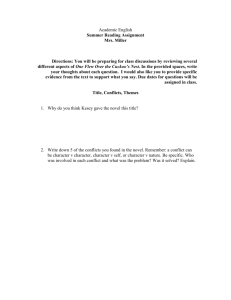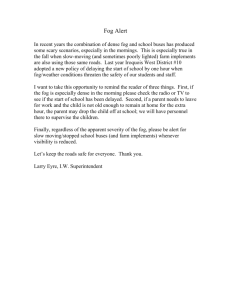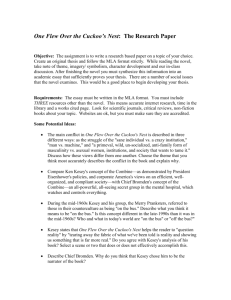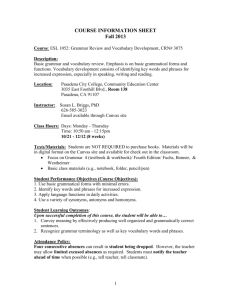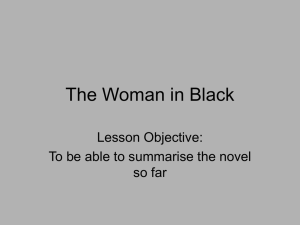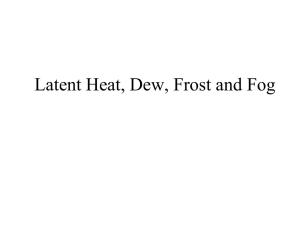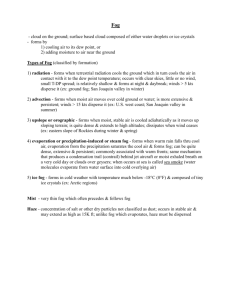English III--Beery Weekly Letter 24 February 1-5
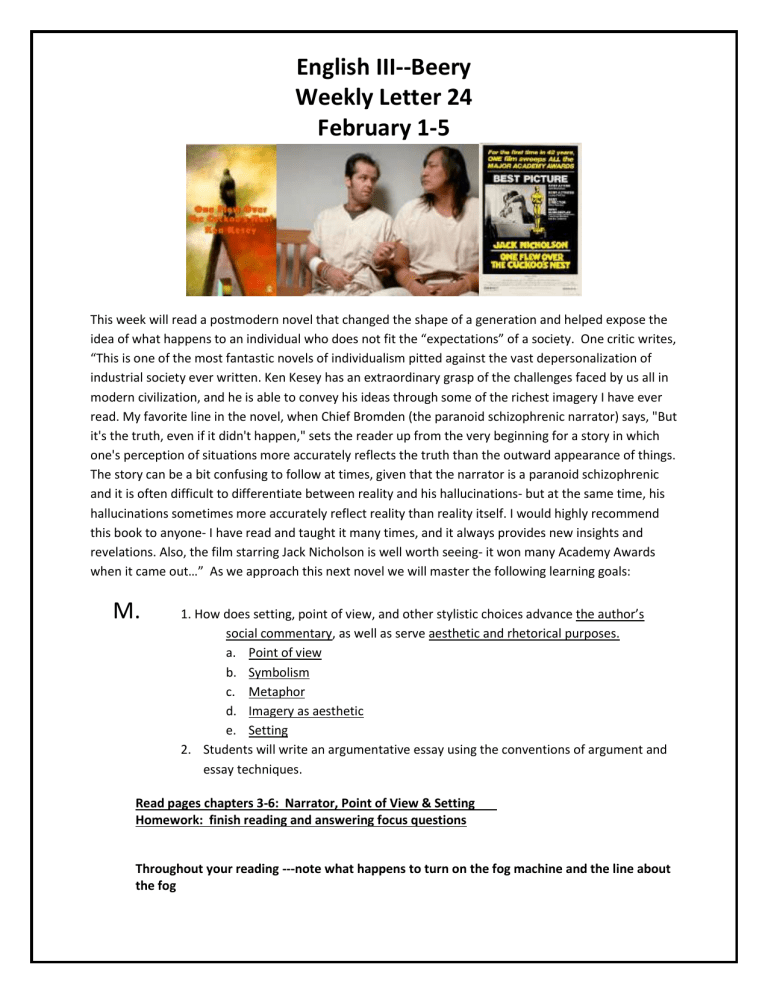
English III--Beery
Weekly Letter 24
February 1-5
This week will read a postmodern novel that changed the shape of a generation and helped expose the idea of what happens to an individual who does not fit the “expectations” of a society. One critic writes,
“This is one of the most fantastic novels of individualism pitted against the vast depersonalization of industrial society ever written. Ken Kesey has an extraordinary grasp of the challenges faced by us all in modern civilization, and he is able to convey his ideas through some of the richest imagery I have ever read. My favorite line in the novel, when Chief Bromden (the paranoid schizophrenic narrator) says, "But it's the truth, even if it didn't happen," sets the reader up from the very beginning for a story in which one's perception of situations more accurately reflects the truth than the outward appearance of things.
The story can be a bit confusing to follow at times, given that the narrator is a paranoid schizophrenic and it is often difficult to differentiate between reality and his hallucinations- but at the same time, his hallucinations sometimes more accurately reflect reality than reality itself. I would highly recommend this book to anyone- I have read and taught it many times, and it always provides new insights and revelations. Also, the film starring Jack Nicholson is well worth seeing- it won many Academy Awards when it came out…” As we approach this next novel we will master the following learning goals:
M.
1. How does setting, point of view, and other stylistic choices advance the author’s social commentary, as well as serve aesthetic and rhetorical purposes. a.
Point of view b.
Symbolism c.
Metaphor d.
Imagery as aesthetic e.
Setting
2.
Students will write an argumentative essay using the conventions of argument and essay techniques.
Read pages chapters 3-6: Narrator, Point of View & Setting
Homework: finish reading and answering focus questions
Throughout your reading ---note what happens to turn on the fog machine and the line about the fog
Focus Questions
SETTING:
Kesey spent time working as an orderly at Menlo Park Veterans Administration mental hospital and, as he put himself in a quasi-schizophrenic state through use of psychedelic drugs, he found that he was unable to “preconceive, and when preconception is fenced out, truth is liable to occur (Kesey qtd. in Pratt).
Based on the above quote and what you know about “the Ward,” why might Kesey have chosen a mental institution as the setting of a novel that is clearly critiquing society as it relates to the individual?
Why is having the Chief narrate as opposed to Big Nurse, Billy Bibbit, or McMurphy a good choice to help to build on Kesey’s choice of setting?
1.
2.
What do know about the narrator and how he sees the world? Choose 3 lines and explain what we can infer about him.
3.
What is ironic about the narrator’s name, Chief Broom?
4.
How are the orderlies portrayed by the Chief?
5.
How does the Chief portray Nurse Ratched? (provide text evidence)
6.
Metaphor: The Combine and the fog—find the lines where these two things are mentioned.
Analyze each one’s significance. (Power Point to add significance)
Pg. 8-“I been silent so long now it’s gonna roar out of me like floodwaters and you think the guy telling this is ranting and raving my God; you think this is too horrible to have really happened, this is too awful to be the truth! But, please. It’s still hard for me to have a clear mind thinking on it. But it’s the truth even if it didn’t happen.”
7.
Where is the Chief as he introduces the day room and the patients?
8.
What does McMurphy want that is so dangerous?
9.
Interpret these quotes: a.
Pg 27-“He is what we call a ‘manipulator’…a man who will use everyone and everything to his own ends…”
“…in a mental hospital? What could his end be?”
“Comfort and an easy life, for instance; the feeling of power and respect, perhaps, monetary gain—perhaps all of these things. Sometimes a manipulator’s own ends are simply the actual disruption of the ward for the sake of disruption. There are such people in our society.”
10.
What role does race and racism play in the book? Use text evidence to support answer
11.
Predict: Why do you think Kesey chooses to tell the story through the Chief?
T: On demand writing
:
Definition: American Society= (define)
Prompt: Argue how an American society works for or against the individual?
Share answers from in-class writing
W
: SYMBOLS/MOTIFS
Homework is to read pages ch 7-11 and complete focus questions
Focus Questions:
POINT OF VIEW:
Point of View: Because the Chief's reality—his point of view—is surreal, the reader's understanding of REALITY is also disoriented, dreamlike and fantastic; but in doing this, Kesey is not trying to confuse the readers but force the them to think about the
WHY in a different way than they could without Chief's schizophrenic perspective.
In some way, this is taking Fitzgerald's Nick's perception of the “unreality of reality” and flipping it.
Instead of creating events that can actually happen but seem impossible (like 1 man messing with the faith of an entire people (Crucible), like 1 boy creating his future fame and fortune lying in the bed of a poor North Dakota farmer, like 1 guy creating a whole world—complete with hundreds of extras—just to win back the love of his life, like one woman killing another and never looking back (Gatsby), Kesey creates a world that reflects the reality of unreality.
1.
What is “real” about Chief’s “unreal” perceptions? Consider the Combine, the descriptions of the Big Nurse and the black boys, the guy on Disturbed who dies in the night, and the fantasy of Mr. Taber living on the Outside after getting lobotomized?
2.
Combine--COMPLETE POWERPOINT EXERCISE
THE COMBINE AND FOG WORK TO HELP DEVELOP KESEY’S CONCEPT OF THE “REALITY
OF UNREALITY,” AND BOTH SERVE RHETORICAL AND AESTHETIC PURPOSES.
3.
“They start the fog machine again and it’s snowing down cold and white all over me like skim milk, so thick I might even be able to hide in it if they didn’t have a hold of me” (7).
Based on the above quote, Chief believes the fog is a part of the machine—the
COMBINE—but I want you to go deeper than that, what other idea may the fog symbolizes in the novel? USE TEXT EVIDENCE TO ANSWER THE FOLLOWING
WHEN APPROPRIATE.
-What are fog’s physical characteristics? What causes fog? When does fog occur?
-When does the fog appear at various points in the novel?
-How does the Chief feel about and interact with the fog? What does the fog prohibit him or enable him to do?
-What conclusions can you make?
At this point, what aspects of society does Kesey seem to be commenting on and what might he be saying about each?
1.
Fog/combine symbolism
2.
Narrator choice
Point of view
3.
Setting (Mental ward)
Aesthetic choice
4.
Narrator choice
Rhetorical choice
Fog
TH:
Silent Reading: Read pages ch 12-19 and complete focus questions
Focus Questions
1.
Considering the choice of setting and how it is a commentary on an individual being accepted into a community. Please respond by writing an extended response:
“I’ve heard that theory of the Therapeutic Community enough times to repeat it forwards and backwards—how a guy has to learn to get along in a group before he’ll be able to function in a normal society; how the group can help the guy by showing him where he’s out of place; how society is what decides who’s same and who isn’t, so you got to measure up. All that stuff….He tells the whole goal of the Therapeutic Community is a democratic ward, run completely by the patients and their votes, working toward making worthwhile citizens to turn back Outside onto the street” (49).
“Our intention, he usually ends by saying, is to make this as much like your own democratic, free neighborhoods as possible—a little world Inside that is made-to-scale prototype of the big world
Outside that you will one day be taking your place again” (5).
2.
Discuss the effect of the Therapeutic Community on 3 of the patients.
Preview of next reading: “What you s’pose it’d be like if evahbody was to brush their teeth
whenever they took a notion to brush?”
3.
What is the Chief’s conception of time? Use lines from the reading to support your response.
4.
Describe the atmosphere of the day room.
5.
The Chief has had 2 flashbacks to his past. Summarize what happens in each and explain why you think he remembers his past when he does.
6.
Page 85-What does the Chief imagine is going on inside the walls of the building?
7.
What happens to give credence to the Chief’s imaginings?
8.
Why is this line significant? “I know he’s telling her about McMurphy brushing his teeth, completely forgetting to tell her about the old Vegetable who died during the night” (95).
9.
What happens to the men as McMurphy’s presence begins to influence the ward?
F: Discussion

